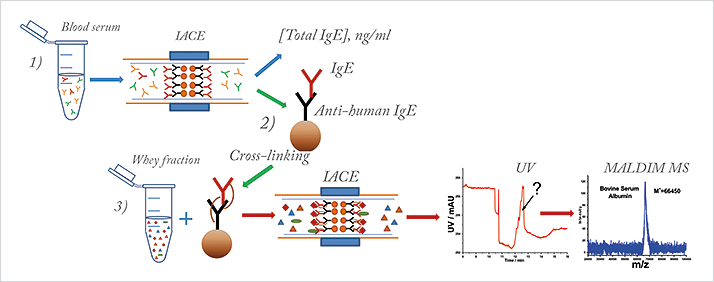Milk allergy is one of the most common food allergies, and although it can be diagnosed, most standard tests do not typically reveal the trigger protein. And such proteins could also be present in other foods. Researchers in Switzerland have developed a new “personalized” test for milk allergy that identifies the specific proteins responsible for an individual’s allergic response, including unexpected or previously unknown allergens.

“The current tests used in clinics use only known allergens to test the patient’s blood or serum, disregarding the unexpected allergens. And the standard methods used in academic laboratories to discover new allergens are typically very time consuming and laborious,” says Natalia Gasilova, a researcher based at Laboratoire d‘Electrochimie Physique et Analytique and one of the authors of a recent study (1). The researchers hope that increased knowledge of culprit proteins will help to improve the development of customized therapies, personalized allergy diagnostics, allergen epitope mapping, and cross-reactivity studies. Gasilova and her colleague, Hubert Girault, used immunoaffinity capillary electrophoresis (IACE) coupled with matrix-assisted laser desorption/ionization mass spectrometry (MALDI-MS) to perform component-resolved diagnostics that identify the source of the allergy. The first step was to quantify immunoglobulin E (IgE) in the milk-allergic patient’s blood serum using magnetic beads coated with antihuman IgE antibodies. Next, the immunocomplex formed by antihuman IgE antibodies binding the patient’s IgE antibodies were chemically cross-linked. Finally, the chemically cross-linked complex is used to bind and identify the individual protein allergens, using IACE with UV and MALDI-MS detection. In addition, allergy component resolved diagnostic testing was performed directly on milk fractions. Results were confirmed with a classical enzyme-linked immunosorbent assay of total and specific IgE antibodies. “MALDI-MS is used for the detection of the proteins trapped and separated during the IACE step,” explains Gasilova, “It provides the mass of the eluted molecules and, therefore, identification of the allergens. In the current work, we did not detect any unusual or unknown allergens for the patient, but if this were the case, we could also perform MALDI-MS/MS analysis of the tryptic digest of the new protein to identify its structure and nature.” One of the main challenges was sensitivity, particularly for low concentrations of analytes. Gasilova explained that the IACE procedure allowed analyte preconcentration prior to detection. Another issue, which is found in all immunoaffinity-based methods, was the elimination of the nonspecific interactions that can give false-positive results, especially for such complex samples. Although the technique was tested for milk allergy, Gasilova believes that it can be adapted to any kind of allergy. Indeed, Gasilova and Girault are now testing and optimizing the current conditions of IACE for the preconcentration/separation of pollen allergens.
References
- N. Gasilova and H. H. Girault, “Component- Resolved Diagnostic of Cow’s Milk Allergy by Immunoaffinity Capillary Electrophoresis– Matrix Assisted Laser Desorption/Ionization Mass Spectrometry”, Anal. Chem., 86 (13), 6337 (2014).




